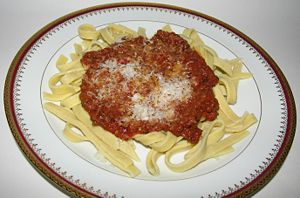Bolognese sauce

Bolognese served on homemade tagliatelle with freshly grated Parmigiano-Reggiano cheese.
Bolognese sauce (ragù alla bolognese in Italian, or sometimes simply ragù) or Bolognese is a well-known pasta sauce that originated in Bologna, Italy. Although its primary ingredient is meat, Bolognese is often thought of as being a tomato sauce. In Bologna, however, authentic recipes generally have only a modest amount of tomatoes, in some recipes none at all. It is traditionally served with freshly made tagliatelle or other robust pastas. "Equally classic," says Marcella Hazan, "is Baked Green Lasagne."[1] In spite of how it is frequently served in the United States and elsewhere, she writes that: "Curiously, considering the popularity of the dish in the United Kingdom and countries of the Commonwealth, meat sauce in Bologna is never served over spaghetti."[2]
In 1982, the Accademia Italiana della Cucina (the Italian Academy of Cooking), at the request of the Bologna Chamber of Commerce,[3] promulgated a recipe that limited a ragù's ingredients to beef, pancetta (Italian rolled bacon), onions, carrots, celery, tomato paste, white wine, and milk.[4]. Like many classic dishes such as beef bourguignon or sauerbraten, however, there are innumerable means of preparing ragù and for each recipe a number of adherents who argue that only their method is the correct and traditional one. Generally, however, to be considered authentic, a Bolognese should begin with a mixture of finely chopped onions, carrots, and celery sautéed lightly in finely diced pancetta—which renders its fat—and/or butter and possibly olive oil. This mixture is known as a soffritto. Ground beef (and perhaps ground veal and/or ground pork) is then added and browned. Other ingredients during the lengthy cooking process include milk and/or cream, white wine, tomatoes or tomato paste, meat broth, nutmeg, salt, and pepper. Some chefs believe that a successful ragù can be produced with only a few hours of simmering; others, however, insist that three or four hours, or even more, are needed. When served with pasta it is almost always accompanied by grated Parmigiano-Reggiano cheese.
| A typical Bolognese sauce preparation | ||||||||||||||
| ||||||||||||||
A recipe for Bolognese sauce
The following recipe was inspired by that detailed by Marcella Hazen in her iconic book but has been modified in several small ways and has been completely rewritten. It is, however, well within the classic definition of a ragù as promulgated by the Italian Academy of Cooking.
For 6 to 8 large servings
2 tablespoons olive oil
3 tablespoons butter
3 ounces pancetta or bacon, finely chopped
1/2 cup minced onion (1/2 medium onion, or 2 ounces)
2/3 cup minced celery (3 medium stalks, or 3 ounces)
2/3 cup minced carrot (2 medium carrots, or 3 ounces)
2 medium cloves garlic, peeled and finely minced
1/2 pound plus 2 ounces ground beef (10 ounces)
1/4 pound plus 2 ounces ground pork (6 ounces)
1/4 pound ground lamb (4 ounces)
1/2 teaspoon black pepper, altogether, plus probably a little more
1 teaspoon salt, plus a little more
1 cup whole milk
1/4 teaspoon nutmeg — plus a little more, to taste
1 cup dry white wine or 3/4 cup dry white vermouth
35 ounces canned tomatoes — whole, chopped, or crushed (1 28-ounce can plus 1/2 of a 14-ounce can, or 2-1/2 14-ounce cans)
1 medium (14-ounce) can unseasoned tomato sauce
sprinkling (1/16th teaspoon) red pepper flakes, plus probably a little more
1 teaspoon sugar
1/2 dry cup red wine
1 cup water, plus more as the sauce cooks, in ½ cup increments
- Chop the pancetta by hand; pulse the onion, celery, and carrots in the food processor until fairly fine but not mushy.
- Heat the oil and butter in a large casserole and cook the vegetables and pancetta over medium heat for 2 or 3 minutes. Mince the garlic in the food processor, add to the vegetables, and stir another minute.
- Add the meats, the salt, and 1/4 teaspoon of the 1/2 teaspoon black pepper. Raise the heat to high and cook, stirring, until the meat has lost its red color.
- Add the milk and cook until all the liquid has bubbled away. Be very careful not to let the mixture burn.
- Add the nutmeg and white wine and cook until the liquid has completely evaporated. Once again, be very careful not to let it burn.
- Pulse the tomatoes (if necessary) in the food processor, then add to the pot, along with the sugar, the red wine, another 1/4 teaspoon of black pepper, the tomato sauce, a tiny bit of red pepper, and the water. Taste carefully for more salt, pepper, and nutmeg. Bring to a simmer, then place on a heat diffuser, reduce the heat, and cook uncovered at the barest simmer for 3 to 8 hours, stirring from time to time, and adding water from time to time. Don’t let it burn! Do not remove any oil that rises to the surface — stir it back in. Cook down to a nice consistency. The longer the cooking the better the sauce, apparently, at least up to 8 hours — after that there may be a point of diminishing returns.
Serve on buttered pasta with Parmesan cheese.
References
Sources
- Essentials of Classic Italian Cooking, by Marcella Hazan, Alfred A. Knopf, New York, 1992






